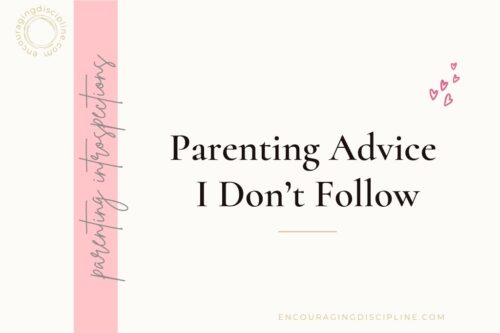How to Deal With Tantrums
Tantrums are the natural way that children release stress, anxiety, sadness, and other uncomfortable emotions that build up in their bodies. Find out the best way to deal with them and what to do, step-by-step, when a child starts screaming, hitting, or throwing things in a raging fit.
So how should we deal with tantrums? How do we set limits and make sure our children don’t hurt themselves, others, or destroy things?
Table of Contents
New Perspective on Tantrums
The first step in dealing with tantrums is to have a perspective shift.
Culturally we have been programmed to view tantrums as bad and to try to stop them. They are loud, disruptive, they annoy other people, and they may even be destructive. And, probably most importantly, they make all of us feel extremely uncomfortable.
But I invite you to think of tantrums in a whole new way. Tantrums are natural, normal, and healing. We should expect tantrums and appreciate them.
Why Do Tantrums Happen?
Take a moment to think about this: what feelings have you had today, from the moment you woke up until now?
As we all go through our day, children and adults alike, we are visited by a multitude of emotions. We may feel energized, inspired, optimistic, proud, determined, frustrated, annoyed, angry, ashamed, overwhelmed, sad, tired, loving, tender, nostalgic… All in one day!
Some of these feelings we may like more than others. Some we may feel more freedom to allow and express. Others not so much.
But the important thing to remember is this: whenever we don’t express our feelings, because of our upbringing that conditioned us to hide it or because it may be an inopportune time to let it come out, bad things happen. Any emotion that is not allowed to come out to the surface gets stuck in our body. And later, another unpleasant emotion comes and joins it.
Nevertheless, when our body is full of uncomfortable emotions, it needs to let them go. Just like a balloon that got too much air pumped into it. If we’ve let the symbolic balloon fill up too much, then it usually explodes. In children, it may look like screaming, throwing, or crying. It may not look much different in adults either. We call this a tantrum.
The Knowledge That Shifted My Perspective
The difference between adults and children is that we have learned how to control our reactions (for the most part) and to postpone the release of this unpleasant build-up.
Children, on the other hand, have a much more immediate reaction. Just like pooping. When it comes, they let it go. When big emotions flood our children’s bodies, they let them do their process of going through the body and leaving it.
This immediate release happens in children because they do not have the part of the brain that is necessary for learning the skills that would allow them to postpone the reaction (the reaction being the release of emotions). Think of it as something similar to how, when they are very young, they need a diaper until they are ready to learn to control their bowel movements.
Once I understood this, it was much easier for me to tolerate and respond to my children’s tantrums in a kind manner.
Tantrums Are Normal
Has anyone told you, “My children never behaved this way”?
Contrary to what your neighbor, judgy family member, or store onlooker tells you, all children have tantrums.
While some children may be more sensitive, intense, or otherwise more prone to having tantrums, and others have tantrums more rarely or less intensely, all children experience them. Tantrums are as normal as sleeping, eating, and excreting. The reason is that, as humans, we have all kinds of feelings ALL the time. It’s part of being human and we cannot help it.
What Should We Do When Our Child Has a Tantrum?
First of all, I will start by saying that there is no need to try to “calm” a child’s tantrum. It would be like a child having to use the potty and we are trying to talk them out of it. We just wouldn’t do that.
If we allow the unpleasant feelings to leave our child’s body, then they calm down on their own. And they feel much better afterward.
On the contrary, we can prolong the tantrum and make it more painful if we do many of the things that mainstream discipline advice recommends, such as:
- give a time out
- threaten the child
- give the child a “reason to cry about” (we all know what that means)
- or give them what they want to make them stop.
By doing any of these things, we do not allow the full release of emotions, so they remain stored in the body, dormant, waiting for another chance to come out.
Another consequence of these strategies is that our child develops unhealthy beliefs that no parent wants their child to have. When we punish our child in any way, they interpret it as a withdrawal of our love. In their mind, they think, “Why would someone who loves me hurt me and make me feel bad?”
But our child doesn’t stop there. They conclude that they must be bad and unworthy of love if their parent decided suddenly that they don’t love them anymore. Children tend to see things as permanent and general because they do not have an understanding of time, emotions, human nature, and life, in general. Their experience is quite limited, as we know.
Related: How to Get Better Behavior with Special Time

Dealing with Tantrums Step-by-Step
1. Mindset
The first step when our child is having a tantrum is to take a few deep breaths and remind ourselves that this is natural, expected, and part of the human experience and development. Leave judgments of your child or the situation. Leave fears that we may be judged by others.
2. Make It Private
Bring your child to a private, safe space. There are two reasons for this. One is to keep everyone else safe. And the second reason is to offer privacy. No child likes to have a tantrum. It just doesn’t feel good to not be in control. And to have it while other people are looking and judging is only adding to the stress. This is why we want to offer our child a safe, intimate space to have their tantrum.
3. Welcome
Get down low, to your child’s level, to create a safe, non-threatening presence.
Have a soft face and expression in the eyes.
Breathe slowly to have a calming presence.
Have arms open, always ready for a hug if your child wants one.
4. Soothe
Use no words or very few words. A child who is in the throes of a tantrum cannot process what we are saying. However, they will hear the tone of our voice, which should be soothing and loving. We can say things such as:
“I am here with you.”
“You are safe.”
“I am not leaving you.”
“This is hard for you.”
“You can do this.”
Some children find it distracting to hear us talk at all. Whenever my son was having a tantrum, he would yell at me to stop talking if I tried to say anything soothing to him. He just wanted me to sit with him quietly while he was going through his process.
5. Normalize
Show acceptance, love, patience, and containment. We have to show our child that we are not afraid or intimidated by their reactions. This is normal, we are just here, sitting with them, waiting it out. We are keeping them safe. And we still love them through it all.
6. Let Go
Do not take anything personally! Not the insults, nor the hitting. Our child is having a hard time. We are just witnessing a natural process and helping our child through it.
7. Stay Present
Stay with your child the whole time. Do not leave a child who is having a tantrum alone. There are many reasons for this. It can be a very scary experience for them. They may hurt themselves or destroy things. Or they may want to stop the feelings and that’s easier if they’re not in our presence.
Try to follow your child’s lead and also pay close attention to all clues when it comes to how close or how far to sit.
When my son was having his tantrums, he would yell at me to go away, and at the same time, he was holding me tightly, pulling me over his body. At first, I wasn’t sure what to do, but after a while, I realized that the words he was saying had no meaning and that he wanted to feel me very close as if I were protecting him from something.
8. Protect
We are protecting our child in two ways. We don’t want them to hurt themselves. And we don’t want them to hurt others.
If your child is hitting, block the attacks firmly, yet gently enough to not cause any pain. Never allow your child to hurt you, themselves, or to break things. If children cause any harm or damage, they feel worse afterward. So if we are making sure that they are harming no one and nothing, we are protecting them from feeling shame or like a bad person.
If our child is very violent, then we may need to hold her into a bear hug, with their back toward us. We do not want to squeeze them to the point that we are hurting them. This is just enough to make sure that they are not hurting us, themselves, or any property.
My daughter has always been a very strong child physically and her tantrums were particularly trying. She was one who needed to be held so she could fight and scream until she sweated and got rid of all her yucky emotions. As she got older, she learned to ask for a play fight. Even to this day, she comes to me and tells me, “I want us to have a fight. I feel like I need it.” It’s her way to release emotions.
9. Limit
Restate the limit if your child is asking for it.
When my son was starting to feel a little better, toward the end of the tantrum, he would make his request again, “Now can I have the tablet?” or whatever his initial request had been. I would reply gently, in a soft voice, “No, sweetie, you can’t have the tablet.” Then there would be more crying. Maybe not as intense as before. But my son still had some feelings to let go of. The way I looked at it was my son needed me to help him release all his feelings by holding the limit for him.
The other way to help our child squeeze out the last bit of yucky emotions is to gently repeat the limit.
“You really wanted me to give you the tablet and I said no.”
If our child begins crying again, then that means they’re not done releasing. If they’re all done, they will be able to confirm or agree without crying.
10. Celebrate
Congratulate yourself and your child. “You did really hard work. I am so proud of you.”
It was great emotional work for both of you! Witnessing a tantrum can be draining. Make sure you take some time to recharge and show yourself some love afterward.
Related: Teach Kids Effective Calm-Down Tools
How Do We Know a Tantrum Is Over?
If our child experiences a full release of unpleasant emotions, then they will become soft, will want a hug, and will soon be ready to play. A few minutes later they may surprise everyone by behaving as if nothing ever happened.
After children unload uncomfortable emotions, they are able to talk coherently again. Then we can reason with them.
Final Thoughts
To clarify, this is not permissive parenting. We are not giving in to our children’s requests. We are holding a limit firmly, but we are doing it gently and with the knowledge that our children need our help and protection to release some emotions that are bothering them. And we are doing this in a way that doesn’t damage our relationship. If we offer an empathetic and accepting presence, our children will learn that we are their safe base and they can trust us to love them completely. No matter what.







